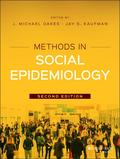Methods in Social Epidemiology
Public Health / Epidemiology and Biostatistics

2. Auflage April 2017
608 Seiten, Softcover
Wiley & Sons Ltd
A thorough, practical reference on the social patterns behind health outcomes
Methods in Social Epidemiology provides students and professionals with a comprehensive reference for studying the social distribution and social determinants of health. Covering the theory, models, and methods used to measure and analyze these phenomena, this book serves as both an introduction to the field and a practical manual for data collection and analysis. This new second edition has been updated to reflect the field's tremendous growth in recent years, including advancements in statistical modeling and study designs. New chapters delve into genetic methods, structural cofounding, selection bias, network methods, and more, including new discussion on qualitative data collection with disadvantaged populations.
Social epidemiology studies the way society's innumerable social interactions, both past and present, yields different exposures and health outcomes between individuals within populations. This book provides a thorough, detailed overview of the field, with expert guidance toward the real-world methods that fuel the latest advances.
* Identify, measure, and track health patterns in the population
* Discover how poverty, race, and socioeconomic factors become risk factors for disease
* Learn qualitative data collection techniques and methods of statistical analysis
* Examine up-to-date models, theory, and frameworks in the social epidemiology sphere
As the field continues to evolve, researchers continue to identify new disease-specific risk factors and learn more about how the social system promotes and maintains well-known exposure disparities. New technology in data science and genomics allows for more rigorous investigation and analysis, while the general thinking in the field has become more targeted and attentive to causal inference and core assumptions behind effect identification. It's an exciting time to be a part of the field, and Methods in Social Epidemiology provides a solid reference for any student, researcher, or faculty in public health.
About the Editors xvii
About the Authors xix
Preface xxvii
1 Introduction: Advancing Methods in Social Epidemiology 1
Jay S. Kaufman and J. Michael Oakes
PART ONE: MEASURES AND MEASUREMENT 21
2 The Measurement of Socioeconomic Status 23
J. Michael Oakes and Kate E. Andrade
3 Measuring and Analyzing "Race," Racism, and Racial Discrimination 43
Saffron Karlsen and James Yzet Nazroo
4 Measuring Poverty 69
David M. Betson and Jennifer L. Warlick
5 Health Inequalities: Measurement and Decomposition 91
Sam Harper and John Lynch
6 A Conceptual Framework for Measuring Segregation and Its Association with Population Outcomes 132
Sean F. Reardon
7 Measures of Residential Community Contexts 158
Patricia O'Campo and Margaret O'Brien Caughy
PART TWO: DESIGN AND ANALYSIS 177
8 Community-Based Participatory Research: Rationale and Relevance for Social Epidemiology 179
Paula M. Lantz, Barbara A. Israel, Amy J. Schulz, and Angela G. Reyes
9 Social Network Analysis for Epidemiology 212
David A. Shoham and Lynne C. Messer
10 Fieldwork with In-Depth Interviews: How to Get Strangers in the City to Tell You Their Stories 239
Melody L. Boyd and Stefanie DeLuca
11 Experimental Social Epidemiology: Controlled Community Trials 254
Peter J. Hannan
12 Propensity Score Matching for Social Epidemiology 283
J. Michael Oakes and Pamela Jo Johnson
13 Longitudinal Approaches to Social Epidemiologic Research 308
Magdalena Cerdá and Katherine M. Keyes
14 Fixed Effects and Difference-in-Differences 341
Erin C. Strumpf, Sam Harper, and Jay S. Kaufman
15 Fixed Versus Random Effects Models for Multilevel and Longitudinal Data 369
Ashley Schempf Hirai and Jay S. Kaufman
16 Mediation Analysis in Social Epidemiology 398
Arijit Nandi and Tyler J. VanderWeele
17 A Roadmap for Estimating and Interpreting Population Intervention Parameters 432
Jennifer Ahern and Alan E. Hubbard
18 Using Causal Diagrams to Understand Common Problems in Social Epidemiology 458
M. Maria Glymour
19 Natural Experiments and Instrumental Variables Analyses in Social Epidemiology 493
M. Maria Glymour, Stefan Walter, and Eric J. Tchetgen Tchetgen
Index 539
Jay S. Kaufman, PhD,is Professor and Canada Research Chair in Health Disparities in the Department of Epidemiology, Biostatistics and Occupational Health at McGill University, and Visiting Professor in the School of Public Health of the University of Chile. He is an editor at the journal "Epidemiology" and an associate editor at "American Journal of Epidemiology", and has been awarded the Rothman Epidemiology Prize (1998), a Robert Wood Johnson Foundation Investigator Award in Health Policy Research (2006-2008), a Fulbright Fellowship (2007) and the Wade Hampton Frost Lectureship (2014).


